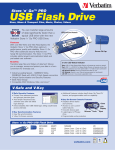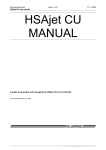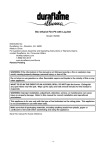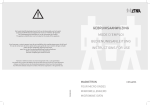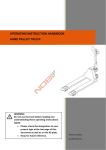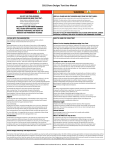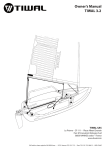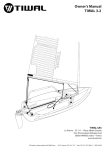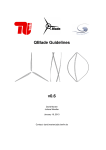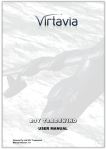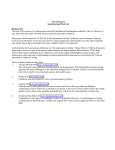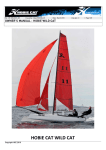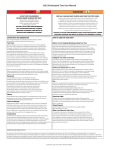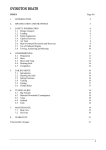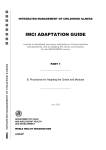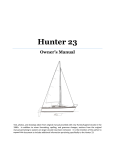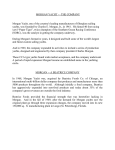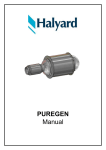Download FCS Owner`s manual
Transcript
FCS Owner’s manual nacra’s premium flight control system Empowering SailOrs SINCE 1975 CAREFULLY READ THIS MANUAL BEFORE OPERATING YOUR FULL FOILING NACRA FCS. IMPORTANT NOTICE Please read this manual and follow the instructions carefully. : This is the safety alert symbol used to alert you to potential hazards including injuries or damage to your vessel or other property. Obey all safety messages that follow this symbol. Throughout this manual you will find special notations: WARNING! WARNING indicates a potentially hazardous situation which, if not avoided, could result in serious injury or death. CAUTION! CAUTION indicates a hazardous situation that, if not avoided, could result in minor or moderate injury All information, illustrations, and specifications in this manual are based on the latest product information available at the time of publication. NAUTICAL SPORTS BV. (NACRA) reserve the right to change specifications or designs at any time without notice and without incurring obligation. PLEASE THREAT THIS MANUAL AS A PERMANENT PART OF YOUR NACRA AND HAND IT OVER TO THE NEW OWNER WHEN YOU TRADE THE CRAFT. WARNING! DO NOT USE THIS PRODUCT UNLESS YOU HAVE READ AND UNDERSTAND THESE WARNINGS, CAUTIONS, AND INSTRUCTIONS WHICH ARE FOR YOUR SECURITY AND PROTECTION. THIS INFORMATION MAY BE SUBJECT TO CHANGE AT ANY TIME. FOR CURRENT UPDATES, PLEASE VISIT OUR WEBSITE AT: WWW.NACRASAILING.COM IF YOU ARE BELOW THE AGE OF 18, YOU SHOULD HAVE YOUR PARENT OR GUARDIAN READ THESE WARNINGS, CAUTIONS AND INSTRUCTIONS AND SHOULD NOT USE THIS PRODUCT UNLESS YOU ARE UNDER THE PROPER GUIDANCE AND SUPERVISION OF SUCH A PERSON. The use of this product exposes the user to many unavoidable and unexpected risks, serious injury or death, DANGERS and HAZARDS. The suppliers of this product are not responsible for any damage to property or any personal injury caused by any use, misuse, abuse or irresponsible use of this product by the user. Sailing must be taken seriously and we recommend that, at least in the early stages of your use, you seek the guidance of professional instructors. Improper and/or unreasonable use of this sailing craft may result in DEATH or SERIOUS INJURY to ANY part of your body and to OTHERS. Do NOT use your sailing craft near power lines, airports, buildings, automobiles, trees, streets, parking lots, rocks, piers, breakwaters, buoys, etc. Always sail and fully foil in an open area and observe wind and weather conditions, particularly in circumstances where you may encounter offshore, onshore, variable or strong winds. Spend time to become familiar with the operation of your Nacra and remember that you are responsible for its operation and for the security of those around you. As you learn the sport, work within your own limitations and do NOT exceed them. During sailing your craft always wear appropriate protective gears and flotation devices. 2 Craft record sheet Model Name Delivery Date N HIN code ISAF Plaque nr Rudder serial # Daggerboard serial # A C Mainsail serial # Starboard Jib serial # Port Gennaker serial # Starboard Port Owner's Name Address City/town Postal code Country Nacra Dealer Address Signature dealer Dealers Stamp 3 Table of content 1. 2. 3. 4. 5. 6. 7. 8. 9. 10. 11. 12. 13. 14. Introduction Safety Information Know your ability level Declaration of conformity Design Category Standard limited warranty coverage Maintenance and service Harken Hardware Maintenance Care of Carbon fiber Parts FCS Foil Settings FCS Foil rake diagram for foil settings One-Design Integrity Maintenance Log FCS Definitions ODCO ISO applicable standards 5 6 9 16 16 17 20 21 22 23 24 25 26 27 4 1. Introduction Dear Customer, Welcome to the Nacra family. We wish to thank you that you choose for Nacra Sailing. It’s our constant endeavour to provide you with products that offer excellent performance throughout their ownerships period. Which is why, in addition to producing great catamarans, we have also set up an extensive dealer network around the world. Naturally, these Nacra Dealers knows everything there is to know about your catamaran and provides you with the best service possible. So please find your dealer in your region on www.nacrasailing.com for any servicing needed and make sure that only genuine spares are used for your Nacra. WARNING! Sailing the Nacra FCS can be overwhelming if not approached in an educated manner. That’s why we have supplied this Owner’s manual and the Assembly Manual. It will help to educate you about your new Nacra and about the ways in which to use it. It contains information regarding the setup, care and maintenance of the systems. Please note that only compatible Nacra systems will benefit from all of the safety and performance functions associated with this Product. This manual will familiarize you with the operation and maintenance of your new Nacra. It will also provide you with the important safety information which should be read and understood before moving on to the assembly manual. The Assembly & operating manuals of our catamarans can be found under the ‘after-sales’ button on our website; www.nacrasailing.com. If this is your first sailboat, or you are changing to a new type of sailboat you are not familiar with? For your own comfort and safety, please ensure that you obtain handling and operating experience before assuming control of the catamaran. Nacra Sailing or National Sailing Federations or yacht clubs will be pleased to advise you about sailing schools or competent instructors. When you have any query, please feel free to contact your local Dealer. Happy Sailing. 5 2. safety information Sailing a fully foiling craft is a hazardous sport, with many disciplines and ability levels. As with all sports, there are inherent risks of injury. The following contains key points to remember when operating your Nacra FCS craft: Be familiar with the Nacra FCS deck lay-out, trim and control systems. Make sure the trim and control system are rigged and used according to the supplied instructions, as written in this manual as in the assembly manual. Make sure your Nacra is maintained well and in good order, a frequent inspection of the Nacra should be made in order to identify punctures, tears, cracks or abrassions of the composite foils, metal fittings, ropes and their knots. Make sure all shackles, bolts and nuts are securely fastened at all time. (see Maintenances for more information) Do not lend your Nacra to someone who has not been fully instructed on the use of this sailing craft. Other users should also read this manual and be proficient in all its points. Check your gear before going on the water. Insure that all systems are rigged properly and are in working order. PROTECTIVE GEAR We strongly recommend the use of the following protective gear: Sailing/Kiteboarding/Snowboarding specific helmet Impact Vest and/or Life Jacket, Flotation Vest Neoprene Wet Suit or a Dry Suit Gloves Foot Protection Eye Protection Flare PLB (Personal Locator Beacon ) transmitter Knife emergency oxygen tank Sunscreen KNOW YOUR ABILITY LEVEL Always sail the Nacra F20 FCS with 2 persons with a minimum weight of 150 kg. Do NOT attempt sailing without appropriate instruction. Make sure you are in good physical condition before using this product. Make sure your are a proficient swimmer before using this product in or near the water. Make sure the wind and water conditions are within your ability level and that you have made the correct equipment choices. Never sail further from the shore that the shore is out of visibility. Always save a reserve of energy before you are exhausted Your are responsible for the proper operation of your Nacra. WIND, WATER, AND WEATHER CONDITIONS Do NOT under estimate the power of the wind. Be aware of unpredictable and changing weather conditions. Avoid strong, gusty wind. Be careful of wave conditions, especially when learning. Be educated about tides and rip currents. Be mindful of your ability level. Do NOT sail if conditions are beyond your ability level. Have knowledge about air and water temperatures and wear appropriate protection against the elements. Do NOT use this product in thunderstorms. Consult an anemometer and weather stations to determine wind speeds if necessary. FULLY FOILING Fully foiling is the term used to define the condition when the weight of the Nacra FCS including the weight of the crew is fully balanced on the lift produced by the foils (e.g. the Daggerboard and Rudder) or both hull are completely out of the water and flying. Approach your first fully foiling sessions in steps to get familiar with this product: Do NOT sail your first ten (10) sailing sessions in windspeeds of 15 knots (28 km/h) or above. Sail your first sessions in flat water or calm seas Take time to get familiar with fully foiling and start with both crews sitting on the deck of the windward hull before you go out on the trapeze. Learn to understand how to react with steering in the transition zone between non foiling and full foiling. When both crews start trapezing begin to stand high in trapeze to prefend you don’t get washed away from the boat (Tea-backing) by a wave or when the boat heels to windward with the leeward hull still flying. CAUTION! Make sure the surface area is always as smooth as possible, particularly the elbow element region of the Daggerboard. As a rough or damaged surface (paint damage) could easily induce ‘ventilation’ of the foil in Full Foiling mode. When the foil ventilates the produced lift will reduce significantly causing the boat to drop out of Foil Foiling mode quite aggressively. 6 BEFORE YOU GO SAILING WARNING! Check for overhead cables when raising or lowering the mast, launching and sailing the boat. So look up when moving the craft around and give any wires a wide berth. A mast which comes in contact with electrical power lines can cause serious injury or death! RIGHTING AFTER A CAPSIZE Even the best sailors capsize occasionally, so prepare yourself and the boat for the inevitable. Install a righting line onto the dolphin striker rod below the mast. The boat will lose speed as it raises up on one hull and usually capsizes over slowly. Hang on to the boat, being careful not to separate yourself from the boat if possible. One of the crew should reboard over the front beam of the catamaran onto the platform to ensure that the craft can not sail away without the crew. The remaining crew can be recovered by the side with the aid of the trapeze wires or crew. Stow the righting line, organize the sheets, and you are sailing again! Minimum crew weight required for righting: As the boat capsizes you may be located in the water or on Nacra F20 Carbon 150 kg Thoroughly check your protective equipment to make the top hull above the water, try to get as fast as possible sure it is in working order and in good condition. onto the bottom hull. It is important to get yourself to the A frequently inspection of the Nacra and the systems bottom hull as quickly as possible to prevent the boat from WARNING! should be made in order to identify punctures, tears or turning upside down (turtle). CAPSIZE RECOVERY any abrasions. Do NOT let go of the boat, as the current and the wind Recover the Nacra FCS as any normal catamaran, by Check the trapeze wires on any wear and breakages, may make it hard or impossible to get back onto the righting it as described in the Owner’s Manual. particularly the ropes of the trapeze system and on wear boat. AVOID physical contact with any sharp ends of the and the knots in the ropes. daggerboards. Secure the drain plugs before sailing and ensure that the Release the main, jib and spinnaker sheets. Reach around NEVER place yourself in a situation were you could be hulls are free of water. Ensure that any hatches are cor- the front crossbar, and throw the righting line over the top in danger of the daggerboards. rectly fitted and have a good seal; hull. Make sure that the bows of the hulls are facing into the Before righting the Catamaran please make sure: Carry your Nacra or use beach wheels with cradles when- wind. Move your weight towards the bow to turn the boat Main traveller-, mainsail- and jibsheet is released. to obtain the proper angle. Be careful not to shift your comever possible to minimize keel wear; bined weight too far forward or afterwards as this may Make sure a third party knows where you are sailing and Bows are facing into the wind cause the boat to roll over and turn turtle. If the mast is how many people accompany you; pointed directly into the wind, the boat may turn over to the Always check the condition of your craft before setting other side when you get the boat upright off. SAILING AND BEACHING NEVER sail above your ability or that of your crew; A sailor’s safety knife should be carried on board; When launching through the surf, always make sure the bow is facing the waves. Always know the direction that the wind is blowing;Watch out for changing weather conditions; Ensure that you and your crew can cope with any changes in the weather conditions; After sailing, remove drain plugs to equalize the pressure in the hulls, if no drain plugs installed, open the hatches; Understand and be competent in the sailing skills and righting techniques. Standing even with the front crossbar, the skipper and crew should grab the righting line, and hike out backwards. You can tie knots in the righting line to prevent your hands from slipping during this procedure. If you are single handling, you may need to carry a righting bag to attain the necessary weight to the boat upright. Once the tip of the mast starts to come out of the water, the boat will right quickly. Be sure to hold onto the righting line until you can grab the boat and pull yourself up onto the deck. Be careful to avoid being hit by the dolphin striker as the boat comes down on top of you. Both daggerboards are pulled fully down and secured by the trimming lines properly cleated in their cleats 7 STABILITY AND BUOYANCY The Nacra catamarans are equipped with one or more sealed buoyancy compartments. The buoyancy compartment is inserted during the build of the hulls. Consequently the following points should be noted: Do NOT puncture the buoyancy compartment. When the buoyancy compartments become punctured do not use the craft until the compartment is repaired. When a hatch is not closed correctly do not use the craft until the hatches are fitted correctly. You may have to replace fittings from time to time. Ensure that all fastenings are resealed properly using an appropriate sealant. The IMCI assessment of these crafts by determined that the crew can upright the craft and will subsequently float. Each of the Nacra Catamaran listed in the Declaration of Conformity have been certified as conforming with the requirements of the UK Statutory Instrument 2004 No 1464 Consumer Protection; the Recreational Craft Regulations 2004 Schedule 1 Parts of Sections 3.2 &3.3; and the EU Recreational Craft Directive 2003/44/EC Annex VI Module Aa & Annex 1 – Parts of sections 3.2 & 3.3. Make sure that the catamaran is NOT too far forward otherwise it may come into contact with the side of your car as you turn corners. Tie the catamaran down to the trailer by using two straps across the width of the hulls using the eyelets on the frame of the trailer. You only need to apply sufficient tension to hold the catamaran in contact with the trailer. Use padded material where any straps touch the deck. Always remove dagger boards, blocks, and rigging when tailoring. Removal of the rudders and steering system is recommended for long distance tailoring. Do NOT use the dolphin-striker as a tie down or for pulling the boat. Use the main beam instead. Secure both ends of the mast. Be sure to mark off both ends of the mast for visibility. Boat covers are recommended to protect against rocks, gravel and road debris while trailing. These covers also provide good protection from weather and the elements. Always leave the drain plugs and inspection hatches open to avoid possible air pressure damage. TOWING AFLOAT Should it become necessary to tow the craft, you should secure the towing line around the Front Cross Beam on one of the sides and as close as possible to the hull. Raise the daggerboards (if fitted) and stay at the tiller. In the event of the loss of the rudder sit well aft. ANCHORING & MOORING Mooring or anchoring of your boat is not recommended. However, if the boat is moored in the water the warranty must be complied with. Barrier and anti-fouling paint must be applied to the bottom. The Nacra range of catamarans are not normally required to anchor/moor, as they are day boats for racing or cruising in inshore or inland waters. OUTBOARD ENGINE The Nacra range of catamarans are not designed for use with an outboard engine. TRAILING AND STORAGE When trailing your Nacra you should only use an approved road trailer. Tying down the craft to its trailer is important because too much or too little tension could result in damage. Follow the instructions below for safe trailing: Ensure the catamaran is properly located on the road trailer and that the boat is balanced correctly. Always use trailers and beach trolleys with cradles designed to fit the hulls rather than rollers. Risk of damaging the hulls occurs when using trailers and dollies without proper support 8 3. Assembly of the Flight control system The assembly of the FCS systems package includes the daggerboards, rudder foil, rudderstock and the associated running rigging with this system. The remaining assembly of the Nacra is covered by the standard Nacra Assembly Manual. 3 . 1 a s s e m b l y o f th e Daggerboards 9 Overview running rigging over and under trampoline DBD EXTENSION TRIM STBD DBD EXTENSION TRIM PORT SHOCKCORD DBD RAKE TRIM 10 3.2. Daggerboard Rake Trim Tie the harken lead rings rope to the shrouds pin and lead the swiftcord DBD rake trim line through these lead rings under the trampoline through the trampoline eye-rings around the worm-drive wheel and back. Tie the beam shockcord to the T2 single 29mm bock. Lead the DBD rake trim line through the harken 29mm T2 single and splice both end into each other as illustrated in the pictures. After splicing sew the splice. Lead the shockcord through the beam to the otherside, tie the 16mm harken block with the polyester rope to the beam casting to reverse the shockcord back the other entry side and tie on the shockcord to the beam casting. 11 3.3. D a g g e r b o a r d E x t e n s io n Trim 3 3. Lead the shockcord through the 18mm soft single block diagonal to the forward corner of the trampoline and tie the shockcord to the most forward trampoline webbing. 4 1. Tie the harken 18mm single block to the trampoline rod in between the 4th and 5th tramp button on 4. Lead the DBD extension lines through the trampoline either side, as illustrated in thought the blocks and back through the trampoline as illusthe overview. trated in the overview. (red and green) 1 5. Lead the 3mm dyneema pull up Haylard through the 2. Tie the 2.3 meter Harken Lead Ring on the shrouds. Tie the double T2 29mm shockcord to 29mm T2 block on the halyard, the dog-bone splicing end will be single block and on this attached to the daggerboard as illustrated on page 9. block the 0.35 meter shockcord, of which the 5 other end is tied to the the second 29mm single block. 2 12 6. Attached the Harken 40 mm Swivel, Becket, Cam Cleat block with the shackle to the deck pad-eye. 6 SHROUDS 8 Be aware you can adjust the cam cleat angle to your desired angle. As illustrated below 9 7. Attached with the supplied pins and Harken instructions attached the 29 mm Pivoting Lead Block to its base mounted on the deck next to the daggerboard-case. 7 8. Lead the extrension line through the daggerboard pull up blocks to create a 4:1 purchase. CAUTION! Do NOT overload the daggerboard pull-up block purchase at any time. Hereby avoiding under loading the shrouds of the mast rigging, as it may cause structural damages and/or breakage. 9. Pull the extension trim line through the daggerboard pull down system as illustrated above. Tie the end with a bowline knot on the 29mm deck block as illustrated below. Make sure the halyard is pulled ‘block to block’ when the daggerboard is fully up onshore to avoid this problem during sailing. 13 3.4 rudder Assembly 8. Mount the rudderstock Rudder is locked 3 on the transom gudgeons using the rudder-pin as illustrated in the figure. 1. Move the rudder lock rod forward inside the tiller-arm by pulling the rope and secure the rope in the clam-cleat. 2. insert the head of the rud- 2 der foil into the rudderstock When afloat, pull the rudder-lock rod forward then 7 extend the rudder-foil to cassette. the desired extension. 3. un-cleat the lock rope and Uncleat the rope and let make yourself familiar how the the rod lock the foil. rudder lock works, by locking Check from above that and unlocking. the lock is properly ex- 4. tie the rope handle as illus- tended into the rudder- trated with two figure-eight foil. knots 5. tie the 4mm shock cord through the same hole with a 8 bowline Unpack the four parts for the rudder assembly A. Rudder-foil B. Rudderstock with rudder-pin C. Rope handle 4mm D. 4mm shockcord 8 6. tie the other end of the 4mm shock cord to the tillerarm end 7. The shock cord and the rudder-lock rod uncleated (pulling backwards) will hold the rud- 1 der foil up in the rudderstock cassette. 5 4 RUDDER LOCK ROD 14 E. Rudder Alignment 1. Put the boat on high support or a trailer to align the rudders. Pull the rudder down so they sit tight in the rudderstock; 2. Take the Philips screw out of the tiller-arm; 3. Place the tiller extension in between the arms; 4. Measure the distance between the leading edges of the rudderblade (see A in the illustration below) and compare this length with the distance between the trailing edges. (see measurement B) For good alignment the distances should be equal to each other or facing inwards between 0-2mm. Hence, the trailing edge (measurement B) distance could be 0 to 2mm longer. Make sure the measurement is done level to the boats beam and perpendicular (same height) to the blades leading and trailing edge . (E.g. as done by the white tape in the illustrations) 5. Check if the rubber rod lengths of the tiller-bar are equal to both sides, to allow proper movement and screw the Philips screw in. Pre-drill the screw hole with a 2.5mm drill bit. A B 15 Name of craft manufacturer: NAUTICAL SPORTS HOLDING BV Address: Town: Postcode: Country: HELLINGWEG 110-116 DEN HAAG 2583 DX THE NETHERLANDS Name of Notified Body: Address: Town: Postcode: Country: ID Number: Date: (yr/month/day) IMCI Rue Abbé Buypers 3 Bruxelle B-1040 Belgique 0609 12/03/09 The Recreational Craft Regulations 2004 Schedule 6 - Module Aa & Schedule 1Parts of Sections 3.2 & 3.3. The EU Recreational Craft Directive 2003/44/EC Annex VI Module Aa & Annex 1 - Parts of Sections 3.2 & 3.3 N460 N500 N570 N580 F16 NACRA 17 N F18 infusion F20 Carbon PCAT005 PCAT006 PCAT007 BPCAT012 BNACRA002 BNACRA001 BPCAT011 BNACRA003 m 4.56 5.08 5.64 5.79 5 5.25 5.51 6.2 m m 2.44 0.2 2.44 0.2 2.44 0.2 2.44 0.3 2.49 0.2 2.59 0.2 2.59 0.2 3.2 0.2 KGS 80 100 130 140 130 148 180 170 Signature: HIN NO: (fill fields below) N A C Brand Name of Craft: Nacra Type or Number: Nacra 460 / Nacra 500 / Nacra 570 / Nacra 580 / Nacra F16 / Nacra 17 / Nacra Infusion / Nacra F20 Carbon. Type of Craft: SAILBOAT Type of Hull: MULTIHULL Deck: FULLY DECKED Type of Propulsion: SAILS Hull Construction Material: PLASTIC , FIBER REINFORCED D PLASTIC Maximum Design Category: C In persons 2 4 4 4 4 4 4 4 KGS 230 340 340 340 340 340 340 340 KGS 357 454 463 526 470 482 470 515 This declaration of conformity is issued under the sole 5. design category responsibility of the manufacturer. I declare on behalf of the This craft is certified and its stability assessed by the IMCI craft manufacturer that the craft HIN code as mentioned under DESIGN CATEGORY C. above comply with all applicable essential requirements in the way specified. CATEGORY C – inshore: Craft designed for voyages in coastal waters, large bays, estuaries, lakes and rivers, where Name and function: Jesse van Leeuwen conditions up to and including wind force of 5 beaufort and (Technical Manager) significant wave heights up to and including 2m may be experienced. Date: ___ /____ /________ DECSCRIPTION OF CRAFT In persons 1 2 2 2 2 2 2 2 M ax im Lo um a Di de sp d la ce m en t T HU BE AM LL HU LL DR AU GH T Lig Di h sp t la ce m en M t i n Re im co um m m Ca end pa e cit d y M a Re xim co u m m m Ca en pa de cit d y M a Re xim co u m m m e Lo nde ad d NG H Model LE Declaration of Conformity of Recreational Craft with the Design, Construction and Noise Emission requirements of Directive 94/25/EC as amended by Directive 2003/44/EC Ce rt i nu fica m te be r 4. d e c l a r a t i o n o f c o n f o r m i t y For ODCO approved ISO APPLICABLE STANDARDS: See page 14. The Nacra range of crafts comply with this design category is subject to: A crew having suitable skill and experience. Satisfactory maintenance of the craft and its equipment. Support the crew even when swamped. Be recovered by the crew after capsize. Users of the craft should comply that: All crew should receive suitable training. Trapeze shall not be used carrying more than 2 persons. The craft shall not carry more than the maximum load. All inspection hatches and drains shall be closed Bilge water shall be kept to a minimum. Stability is reduced by any weight added above the centre of buoyancy. 16 6. Standard limited warranty coverage Down below you will find our warranty details and instruc- I M P O R T A N T N O T I C E S tions. Please follow these instructions so we can identify Online warranty registration: you as a NACRA sailor when warranty issues arise. Make sure to register your boat at www.nacrasailing.com to apply for your warranty. This registration is mandatory 6.1 Term of Conditions Nacra reserves the right, before having any obligation under this limited warranty, to inspect the damaged Nacra Pre-Delivery Inspection product,. All costs for shipping the product to Nacra or Na- A thorough inspection of the new boat prior to delivery encra dealer/distributor for inspection shall be paid solely by sures that the condition of each boat meets the high standthe purchaser, in order to recover under this limited war- ards set by Nacra. We certify that your boat was inspected ranty. The original invoice or warranty card registration according to the procedures established by Nacra. must also be presented of the product. (on-line registration card www.nacrasailing.com, or any other documentation To Obtain Warranty Service Within 10 days of discovering a defect, notify in writing, Nacra deems acceptable) along with proof of purchase (sales receipt or registration) Nacra, at it’s option, shall repair or replace the defective to an authorized dealer or service centre. unit covered by this warranty. This limited warranty does not cover any damage due to accident, misuse, abuse or Maintenance records negligence. Nacra shall approve beforehand any repairs It is also recommended that receipts covering the perforwhich will be carry out under this limited warranty. A quo- mance of regular maintenance be kept with your boat. Damtation must be send to the Nacra Dealer before proceed- age to your boat caused by lack of maintenance is not covings may go forward. Please note, this approval by Nacra ered by our warranty. for the repair does not guarantee the warranty, as the repair is part of the investigation of the warranty proceed- Owner satisfaction Should you ever encounter a problem during or after the ings. warranty period that is not resolved, talk to the managePlease retain the dated sales receipt as evidence of the ment of the dealer or service centre. If the problem persists, original date of purchase. You will need it for any warranty follow the two-stage satisfaction procedure outlined in this service. In order to keep this limited warranty in effect, the section of the owners manual. product must have been handled and used as prescribed in the owner’s manual. new Boat Limited Warranty What is covered? Nacra warrants each new Nacra boat, hereafter called “boat.” The warranty covers repairs to correct any malfunction occurring during the warranty period resulting from defects in material or workmanship. New or remanufactured parts may be used to affect repairs. Only genuine Nacra parts and or Nacra licensed supplier parts should be used for these repairs. The warranty period for all coverage’s begins on the date the boat is first delivered or put in use which ever comes first. The warranty period is 2 years / 24 months. This coverage applies to all owners of the boat. To obtain warranty repairs, take the boat to an authorized Nacra dealer or service centre within the warranty period and agree upon the repairs and/or adjustments required. A reasonable time must be allowed for the dealer/service centre to perform necessary repairs and/or adjustments. Charges for warranty repairs and adjustments (parts and/or labour) will not be applied. What is not covered? Since this warranty applies only to defects in material and workmanship, it does not apply to normal wear and tear, or to damage caused by: 1. Neglect, lack of maintenance, accident, abnormal operation or improper installation and services. Failures due to lack of proper maintenance as described in the maintenance schedule; failure to follow maintenance schedule intervals; failure to use lubricants recommended in the warranty manual. Proof of proper maintenance is your responsibility. 2. Keep all receipts and make them available if questions arise concerning maintenance. 3. Accidents or damage caused by collision, fire, theft, electrocution, freezing, vandalism, riot, and explosion or from objects striking the boat and /or acts of God. 17 4. Misuse of the boat such as overloading, alterations to the boat and or any damage caused by these alterations. Discoloration, crazing, or blistering of gelcoat caused by mooring or storing the boat in water [not recommended; if boat is stored in water, anti fouling is advised. 5. Transportation of boats and/or parts to/or from Nautical Sports BV or its dealers. 6. If your boat is equipped with a Cunningham system purchases over 8:1, Mainsheet over 10:1; please be aware that damages that are due to over-sheeting are not covered. 7. Damage caused by airborne fallout (chemicals, tree sap, bird extractions etc.), stones, hail, earthquake, water or flood, windstorm, lightning, etc. 8. Cleaning and polishing, lubricating performing other normal maintenance services. See maintenance schedule and assembly manual for full details. 9. This warranty does not cover any economic loss including (without limitation) payment for the loss of time or pay, inconvenience, loss of boat use, boat rental expenses, lodging bills, food, other travel costs, storage charges and other incidental or consequential loss or damage. 10. This is the only expressed warranty applicable to your Nacra boat. Neither authorized Nacra dealers/service centres nor Nacra authorize any person to create for them any other obligation or liability in connection with these boats. Any implied warranty of merchantability or fitness for a particular purpose applicable to this boat is limited to the duration of this written warranty. 11. The performance of repairs and needed adjustments is the exclusive remedy under this written warranty. Nacra shall not be liable for incidental or consequential damages resulting from breach of this written warranty. 12. Regarding the hulls, mast, daggerboards and rudderblades; both the hulls and the mast can have intrusion of water; this is due to the nature of use and build of the product. Water tightness therefore is not warranted and or guaranteed. Please check with your local legislator if a mast floatation device is required. Things to know about limited warranty Warranty repair order For your records, the servicing authorized Nacra dealer or service centre will provide a copy of the warranty repair order listing all warranty repairs performed. General We will repair everything covered under warranty that goes wrong during the warranty period that is the fault of the Voiding Warranty manufacturer. In case the repair is performed by a non authorized dealer, service centre or repairer and/or non genuine parts are used Damage / defects the warranty is void. Damages and/or defects caused by this Please note the distinction between “defects” and repair are not warranted. “damage” as used in the warranty: Defects are covered by the manufacturer, but we have no control over damage (Please read the following pages for details) caused by such things as collision, misuse, transportation and lack of maintenance which occur after the boat is delivered to you. Damage, for any reason, which occurs after the boat is delivered to you is not covered under warranty. Maintenance and repairs are recommended to be performed by any authorized Nacra dealer or service centre, who will offer first class service at competitive prices. Warranty repairs must be performed by an authorized Nacra dealer or service centre. Authorized Nacra dealers and service centres reserve the right to deny warranty coverage if the boat has not been properly maintained. After warranty repairs If you have a problem with your boat after the warranty coverage has expired, we recommend you to return to your authorized Nacra dealer or service centre for routine maintenance and repair. Production changes The manufacturer and/or Nacra reserves the right to make changes in boats built and/or sold by them at any time without incurring any obligation to make the same or similar changes on boats previously built and/or sold by them. Wear & Tear exclusions What is excluded? Wear and Tear from normal sailing and usage Discoloration Rust / corrosion Scratching [anodized] parts Your boat and its fittings are designed and built to resist Battens corrosion, but due to outside influence [salt, chemicals etc] Sheets / ropes / shock cords corrosion may occur. Please make sure that your boat is Rubbers rinsed with fresh water after every sail to prevent this Burn holes in the spinnaker due to incorrect snuffing happening. Please refer to the maintenance schedule and/ Rudder alignment or assembly manual for further details. Wear due to beaching the boat Non- structural cracks in gelcoat Warranty service For warranty service, please see the authorized Nacra dealer Misuse or service centre where you purchased the boat. If you are touring or moved, please visit any authorized Nacra dealer or service centre for warranty service. The nearest authorized Nacra dealer or service centre can be found on our website: www.nacrasailing.com. 18 6.2 owner Assistance If you experience any concerns. Two-Stage satisfaction procedure ONE – Discuss your concern with a member of the authorized Nacra dealer - or service centre management. MAINTENANCE—GENERAL INFORMATION CAUTION! Always wash your boat with fresh water after sailing. Salt water can cause severe corrosion It is essential that your boat receives the maintenance outlined on the following pages to retain the safety, reliability and performance built into your boat. good cover is used and that it prevents any water coming into contact with the sails. Sails will be subject to mould and mildew if left in water. Trailers should be rinsed with fresh water and checked at regular intervals. It is recommended that the trailer be serviced annually. It is also a good idea to tie the craft down when it is left in the dinghy park to prevent any damage in the event of strong winds. Concerns can often be resolved quickly and satisfactorily at that level. If the concern has already been reviewed with the Do not leave the rig under tension when not sailing or during REPAIR sales or service manager, contact the owner of the authorstorage. If rig tension is over tightened, or left on when not Contact your dealer or Nautical Sports BV for the best advise ized Nacra dealership/service centre or the general manager. sailing damage may occur. TWO – In the unlikely event that your concern cannot be resolved by the authorized Nacra dealer or service centre management, contact Nautical Sports BV at [email protected] By doing so you should be prepared to provide the following information in English: Your name, address, telephone number and e-mail. The identification HIN number of your boat (This can be found on the starboard hull stern) The name and address of the dealer. The delivery date of your boat. Details of your concern or request. Including photos and/or quote of repair. Storage It is most important that you store your boat properly, please see page 8 of this manual how your boat should be stored. Please make sure in case you store your boat for longer periods it’s stored in a well ventilated area in order to avoid an osmosis reaction between hulls and any (transport) supports. Transport To make sure that no damage is done to your boat, please see page 8 of this manual. Your boat should only be used with a proper launching trolley. The use of any other trolley may damage the hull and invalidate your warranty. Care must be taken to support the hull adequately if the boat is not stored on the correct launching trolley. Any sustained point loading could permanently dent or distort the hull. MODIFICATIONS Contact your dealer or Nautical Sports BV about any modification. Please remember any modifications may endanger your safety and invalidate your warranty. Any repairs to the hull should be undertaken by qualified personnel with the relevant skills and equipment. Contact your dealer for advice. UV light may cause fading to some components and fittings, a good quality cover is recommended to reduce UV degradation. Keep the equipment clean by frequently and thoroughly flushing with fresh water. Excess water should be removed from the hull and any cavities. Keep your craft drained and well ventilated. Ensure the craft is stored with the bow raised to allow water to drain away. Make sure that when you attach the rudder that the rudder stop clips over the stock. Salt water will deteriorate your sail and the stitching if the sail is not rinsed in fresh water after sailing. Sails should be dried before storing. Ideally we would recommend that you should store sails in a convenient dry place away from the craft. If you have to store sails on the craft ensure that a 19 7. maintenance and service CAUTION! The Nacra F20 carbon FCS designed for minimal maintenance. However, keep your equipment clean and free-running by always flushing with fresh water after sailing. Periodically clean with mild detergent and water solution. Make sure your Nacra is clean and free of any sand or debris before sailing. In order to give the best service and comply with the Nacra limited warranty. Sails Check for broken or delaminated battens. Never sail with damaged battens. Check the sails and trampoline for tears, or loose stitching. Repair immediately to avoid further damage. Please see your dealer Rigging FCS inspection after every Periodically check for and replace frayed, worn, or Inspection before sailing kinked wires, shock cords and lines. 10 days of sailing Platform [hulls & trampoline] Periodically check the bearings in the traveller car and Check the daggerboards and rudderblades on any micro Always keep trampoline lacing tight. replace them if necessary. Rinse thoroughly with fresh cracking. Release the drain plugs in the head of the foils Always check beam bolts to ensure proper torque. water to free any stuck bearings. to drain out any water which may have intruded in to the Check hulls for leaks at all hull fittings Periodically check dolphin striker strap tension. Please foils. Check the trampoline for tears, or loose stitching. Repair see assembly manual for the correct setting for your Check the plastic Trailing Edge protectors in the daggerimmediately to avoid further damage. boat. Adjust as necessary. board cassettes are still able to protect the daggerboards Masts should be regularly inspected for water tightness trailing edge. Sails and diamond wire wear. Make sure fittings are sealed Check for broken or delaminated battens. Never sail with with silicone. Maintenance every 3 damaged battens. Replace wires that show any signs of wear. Check dia Check the sails for tears, or loose stitching. Repair imme- months mond wire attachment points, turn buckles and seizing diately to avoid further damage. wire. These areas could cause serious mast failure! Platform Rigging Check all shackles, clevis pins, and fasteners for loosening or wear. Replace as needed. Tape all split rings and cotter pins to prevent loss or damage. Inspection after sailing Platform & Rigging Rinse ENTIRE boat with fresh water after each use. Be sure to flush all blocks and fittings thoroughly. Sails Rinse sails with fresh water, make sure sails are dry and batten tension is released when storing for more than a day. Never fold your sails Role your sails from top to bottom, this is to prevent luff Damage Check mast ball for wear- replace if: a) Maximum diameter of the plat spot on top of the ball is bigger then 15mm/0.59 inch b) Minimum height from bottom to top should be 35 mm/1,38 inch Check hulls for excessive wear on bottoms from beaching and dragging the boat. Check hulls for leaks at all hull fittings by covering suspected areas with soapy water and blowing air (from your lungs) into the drain plug holes. DO NOT USE COMPRESSED AIR AND OR ANY OTHER TYPE OF MECHANICAL BLOWER AS THE EXCESSIVE PRESSURE CAN DAMAGE THE HULLS. If the water bubbles, there is a leak. Remove the fitting and/or cover with silicone sealant and replace. If the leak is from fiber glassed area (no fittings) this should be reglassed to insure proper permanent bonding. Please see your dealer Conditions which requiring more frequent owner maintenance If your boat is regularly operated under one or more of the following conditions: Temperatures below freezing or above 32°C / 90 F Take extra care when boat is left after sailing when freezing is likely, ensure that hulls are dry. Beach storage Recommended Fluids, Materials and Lubricants. Mast Rivets Tef-Gel® or Sikaflex® 291 Beam bolts Molykote® grease long-term W2 Wax Dulon 2—component boat car r equivalent 20 8. h a r k e n h a r d w a r e m a i n t e n a n c e 21 9. Care of Carbon fiber Parts Care Each carbon-fibre mast and FCS foils (Daggerboard, Rudder- In order to get the maximum life from your carbon fibre blade and rudderstock) delivered by Nacra has been manu- composite we recommend the following care and precaufactured using heat and pressure autoclave curing, the best tions: process available. Since carbon fibre composite is different than aluminium to drill, file, or otherwise process, always contact your Nacra dealer for advice before making any modifications to the mast and foils. Handling & Storage Carbon fibre has properties differing from aluminium. Though carbon composite is stronger than aluminium, it is less resistant to impact loads. Where aluminium will dent on severe impact, carbon composite could shatter or suffer serious delaminating. Clearly, subjecting your carbon spars to severe impact is to be avoided. When transporting your mast it is important to pack it well using covers which are available at your Nacra dealer. Ensure that rigging is removed to prevent the stays from wearing or banging against the mast. It is recommended to fully inspect your mast and foils when re-rigging. Do NOT allow the carbon composite parts to become excessively hot. High performance epoxy resins, together with oven post curing, are used in these composites, however at temperatures above approximately 75oC the epoxy can soften which dramatically reduces strength or otherwise can cause the part to bow or warp. Note that black objects are the best absorbers of IR radiation (heat) and we have recorded a surface temperature of 65oC from a part lying flat on the ground in the sun. Epoxy resins are UV light degraded. Although our epoxy resins have UV light protection, excessive UV light has the effect of turning the exposed epoxy resin into a chalky layer. Therefore it is recommended to keep your mast as much as possible out of the UV light . It is best to cover it when not rigged. Therefore it is also recommended to wax your mast with any UV protection wax e.g. Teflon wax etc. 22 10. F C S f o i l s e t t i n g s PRELIMINARY FOIL SETTINGS - NACRA F20C FCS UPWIND SAILING WIDE SAILED ANGLES -- TWA +80 deg. Extension DBD RAKE in DBD above Elevator rake Sailing Boat Speed Deg. deck in Deg. Mode 5 knots 10 knots 10-14 knots 14-16 knots 16+ knots (positive for LE up) distance DBD above deck (in mm) (positive for LE up) -2 0-1 5.5 5 0-4 Full down 120 420 520 520 0 0 1 0.5 0.5 FF = Full Foiling NF = Non Foiling / semi foiling NF NF FF FF FF Boat Speed 5 knots 10 knots 10-14 knots 14-20 knots 20-25 knots 25-30 knots 30+ knots DBD RAKE in Extension DBD Elevator rake Deg. above deck in Deg. (positive for LE up) distance DBD above deck (in mm) (positive for LE up) -2 1 4.5 4 --> 3 3 --> 2 1.5 0.5 520 320 520 520 520 520 520 0 0 1 0.5 0.5 0.5 0 Mode NF NF FF FF FF FF FF DBD = Daggerboard 23 11. f c s f o i l r a k e d a g r a m f o r f o i l s e t t i n g s 24 12 o n e - d e s i g n i n t e g r i t y m a i n t e n a n c e l o g Proof of Maintenance Proper certification of maintenance will avoid problems covered by warranty, or damage by lack of maintenance. Perform all recommended maintenance to ensure that your boat is kept in good condition. (repair category - warrenty repair / accident Repair / fatigue repair) Repair Date Repair category details of repair done Name and address of servicing retailer stamp stamp stamp stamp stamp stamp 25 13. FCS definitions DAGGERBOARD FOIL PULL-DOWN SHEAVE SLOT UPPER RUDDER GUDGEON (with rake adjustment) DAGGERBOARD RAKE SYSTEM CARBON RUDDERSTOCK LOWER RUDDER GUDGEON DAGGERBOARD RUDDER BLADE ELEVATOR DAGGERBOARD DECK BEARING DAGGERBOARD-CASE DAGGERBOARD KEEL BEARING ELBOW ELEMENT 26 13. o D C O I S O a p p l i c a b l e s t a n d a r d s 27 Connect with your local dealer Your local Nacra dealer is there to serve you - the customers. Please take advantage of the many service that Authorized Nacra Dealers can provide: Manufacturer: Nautical Sports B.V. Address: Hellingweg 110 - 116 2583 DX Den Haag The Netherlands Office: +31(0) 70 338 2900 Fax: +31(0) 70 338 2901 Email: [email protected] Website: www.nacrasailing.com 2013 Nautical Sports B.V. - All rights reserved. New Nacra fully assembled Nacra parts and accessories Expert advice on boat rigging, repair and maintenance A direct source for all catamaran accessories Contacts for multihull fleets and events Distributor / dealer: 28




























